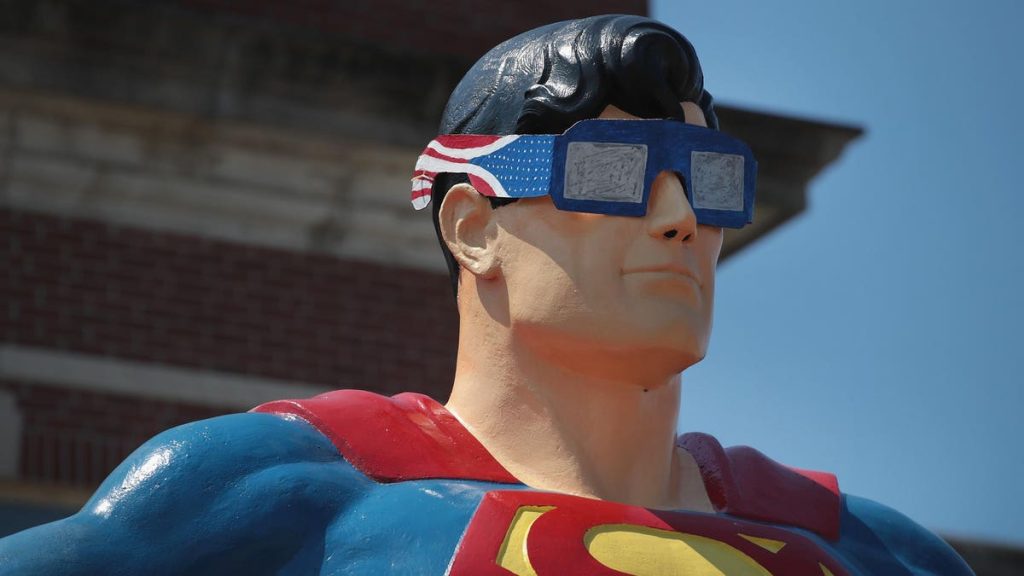On Saturday, October 14, a solar eclipse will be seen from across the U.S. and everyone wants to know where to find solar eclipse glasses. It will be a partial solar eclipse for most, but even where it’s an annular (“ring of fire”) solar eclipse, the sun will never be completely blocked by the moon.
So for everyone, everywhere across the Americas it’s critical to only look at the sun through safe solar viewing glasses or a handheld solar viewer. Sunglasses are not safe.
If you want to purchase safe solar viewing gear online, there’s still time—but it’s running out.
If you can’t afford them, don’t want to pay for them or don’t have time to get them mailed, you may be in luck—but you will have to act quickly.
How To Get Free Solar Eclipse Glasses
Five million pairs of solar protection glasses are being distributed for free to 10,000 libraries across the U.S. as part of the Gordon and Betty Moore Foundation-funded Solar Eclipse Activities for Libraries project. It’s giving out five million solar viewing glasses to 13,000 public libraries across the U.S. It’s the largest single eclipse outreach effort in the U.S.
Use this interactive map to find a library near you that may be giving out free solar eclipse glasses, but don’t waste time. “If you enlarge the map, you can eventually get to individual towns and library names,” said Andrew Fraknoi, an astronomer at the Fromm Institute at the University of San Francisco and part of SEAL, in an email. “But it’s unlikely that libraries will have glasses left on the day of the eclipse—the earlier people get in touch with their library, the better,” he said.
When To Get Free Solar Eclipse Glasses
Each library has about 500 glasses. “People should get their glasses early and save them in an envelope so the special protective material doesn’t get scratched,” said Fraknoi, who adds that many libraries reported the best attended programs in their history before and during the 2017 “Great American Eclipse” when a smaller version of the project took place.
A NASA-funded project from the Astronomical Society of the Pacific has also created a nationwide network of Eclipse Ambassadors that will distribute free solar eclipse glasses at community events, with a focus on underserved communities.
It’s also worth checking at science museums and planetariums, which may be staging free events on October 14, during which you’ll likely receive a free pair of solar eclipse glasses. “If your library is out of glasses, we suggest calling a local planetarium or science museum store, a college book store or a NASA center,” said Fraknoi.
Where To Buy Safe Solar Viewing Glasses
The place to begin your search is on this list of Suppliers of Safe Solar Filters & Viewers, which have all been vetted by the American Astronomical Society.
Although there are dozens of retailers, vendors, resellers and distributors, there are only a few manufacturers of solar protection glasses in the U.S.—American Paper Optics and Rainbow Symphony (the latter in conjunction with Thousand Oaks Optical).
Look for those names on any solar eclipse glasses you buy, as well as evidence that they meet the ISO 12312-2 international safety standard. It’s also worth reading the AAS’ How Can You Tell If Your Eclipse Glasses or Handheld Solar Viewers Are Safe?
Explained: Annular Solar Eclipse
What almost everyone in the U.S. will experience on October 14 is a partial solar eclipse. As an example, those in New York will see 23% of the sun eclipsed while people in Los Angeles will see 71%.
The closer a location is to the central path, the more of the eclipse it will see. That path, which is about 125 miles wide, will stretch from Oregon through Texas across nine U.S. states. Within the path observers will see a “ring of fire,” the colloquial name for an annular (not “annual”!) solar eclipse.
The event occurs because the new moon appears too small to cover the sun completely, leaving a halo of bright sunlight around the moon during a 90% eclipse. That applies to Oregon, northern California, Nevada, a tiny part of Idaho, Utah, northeastern Arizona, southwestern Colorado, New Mexico and Texas.
All of North, Central and South America will see a partial solar eclipse, with parts of Mexico’s Yucatan Peninsula, Belize, Honduras, Nicaragua, Panama, Colombia and Brazil also seeing the “ring of fire.”
Everyone—even those within the path—will need to wear solar eclipse glasses to view any of the event.
I’m an expert on eclipses—the editor of WhenIsTheNextEclipse.com and author of The Complete Guide To The Great North American Eclipse of April 8, 2024. For the very latest on the “ring of fire” solar eclipse—including travel and lodging options—check my main feed for new articles each day.
Wishing you clear skies and wide eyes.
Read the full article here










